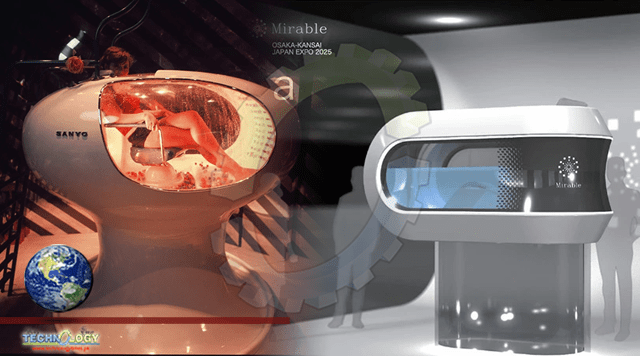A human washing machine, one of the most talked about exhibits at the 1970 Japan World Exposition held in Osaka Prefecture, looks set to make a triumphant return with cutting-age technology when this city hosts a world expo in 2025.

By JUNICHI KAMIYAMA
Those behind the latest endeavor include a designer involved in the original expo project, undertaken by Sanyo Electric Co., and the founder of a manufacturer of bathing systems in Osaka who was dazzled by Sanyo’s exhibit as a young boy.
For the expo 51 years ago, Manatsu Ueda, the Sanyo designer, developed the novel machine with his colleagues at the behest of Sanyo’s founder, Toshio Iue.
Although Ueda initially felt the project was a far-fetched undertaking, it proved to be a huge hit at the fair, held in Suita in the prefecture.
“So many visitors asked us to let them experience our bathing system,” said Ueda, 86. “It was one of the happiest moments in my life.”
The egg-shaped, glass-walled Ultrasonic Bath cleaned, massaged and dried the user in a fully automated process and was put on display at the Sanyo Pavilion.
All the bather had to do was to remain seated. Hot water automatically filled up in the pod once the person sat down, while 300 massage balls and supersonic waves did the rest.
In developing the machine, Sanyo applied its technology used to make pulsator-type washing machines, the first of their kind in the domestic market.
Sanyo’s unusual exhibit drew long lines of expo visitors day after day.
Among them was Yasuaki Aoyama, who later became chairman of Science, an Osaka-based maker of bathing systems that create ultrafine bubbles.
Aoyama, as a fourth-grader, kept returning to the expo to “imprint” the epoch-making machine in his memory. He ended up going dozens of times.
“I was stunned to see a bath where you don’t need to scrub your body,” he recalled thinking back then.
In 2007, Aoyama established a company selling water purification devices that remove chlorine from tap water.
He got the idea for bathing systems as a health care product after learning through a TV program that fine bubbles created by ultrasound waves are used to clean electronic components and chip technology.
“I thought we could take advantage of this technology to clean people’s bodies just by soaking in a bathtub,” he said. “I thought that would prove to be a big help.”
Aoyama, 61, had a personal reason to pursue the endeavor 20 or so years ago as one of his daughters suffered from skin inflammation caused by chlorine in tap water.
The severe rashes meant she was unable to wash herself like other people, which made her a target of bullying at her elementary school. Aoyama took his daughter to numerous hospitals to find a way to ease her condition and pain.
Thumbing through scientific literature, he discovered that chlorine can cause inflammation when it comes into contact with skin. So he asked a friend working at a small factory to create a shower head that can be loaded with chemicals to dissolve chlorine.
His daughter’s condition improved after about three months of taking showers this way.
The experience led Aoyama to start work on developing a bathing system for people with similar problems.
It took several years of hard work, but he finally came up with a method to remove chlorine and dirt from the body’s pores with bubbles measuring just 3 micrometers across.
Aoyama also developed an interchangeable showerhead that creates even finer bubbles for face-washing.
Science’s bathing systems are now used at hospitals and homes due to their ability to thoroughly clean.
Aoyama’s company expects to post 5.7 billion yen ($51.8 million) in sales for the year ended in March, about five times the figure for five years earlier.
“I feel indebted to Ueda because I was able to make my company grow thanks to the encounter with (Sanyo’s) human washing machine,” Aoyama said.
Aoyama is now working on the project to showcase a futuristic version of the human washing machine for the Osaka, Kansai Expo 2025. This version cleans without the person having to soak in water.
Senior staff at Science are brainstorming on the prototype with Ueda and Eiji Yamatani, 80, a former Sanyo engineer who also took part in Sanyo’s human washing machine project.
“We want to offer something that allows people to experience a futuristic lifestyle while sticking closely to the image of our machine in the 1970 expo,” Ueda said. “It would be great if we can score another hit at the expo again.”
Aoyama said he hopes to wow children with their exhibit during the 2025 fair, just as he was just over a half-century ago.
Originally published at The asahi shimbun